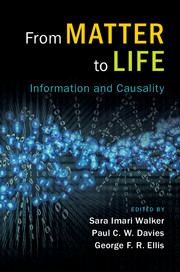Book contents
- Frontmatter
- Contents
- About the authors
- 1 Introduction
- Part I Physics and Life
- Part II Bio from Bit
- Part III Life's Hidden Information
- Part IV Complexity and Causality
- 12 Life's Information Hierarchy
- 13 Living through Downward Causation: From Molecules to Ecosystems
- 14 Automata and Animats: From Dynamics to Cause–Effect Structures
- 15 Biological Information, Causality, and Specificity: An Intimate Relationship
- Part V From Matter to Mind
- Index
12 - Life's Information Hierarchy
from Part IV - Complexity and Causality
Published online by Cambridge University Press: 02 March 2017
- Frontmatter
- Contents
- About the authors
- 1 Introduction
- Part I Physics and Life
- Part II Bio from Bit
- Part III Life's Hidden Information
- Part IV Complexity and Causality
- 12 Life's Information Hierarchy
- 13 Living through Downward Causation: From Molecules to Ecosystems
- 14 Automata and Animats: From Dynamics to Cause–Effect Structures
- 15 Biological Information, Causality, and Specificity: An Intimate Relationship
- Part V From Matter to Mind
- Index
Summary
SUMMARY
I propose that biological systems are information hierarchies organized into multiple functional space and time scales. This multi-scale structure results from the collective effects of components estimating, in evolutionary or ecological time, regularities in their environments by coarse-graining or compressing time-series data and using these perceived regularities to tune strategies. As coarse-grained (slow) variables become for components better predictors than microscopic behavior (which fluctuates), and component estimates of these variables converge, new levels of organization consolidate. This process gives the appearance of downward causation – as components tune to the consolidating level, variance at the component level decreases. Because the formation of new levels results from an interaction between component capacity for regularity extraction, consensus formation, and how structured the environment is, the new levels, and the macroscopic, slow variables describing them, are characterized by intrinsic subjectivity. Hence the process producing these variables is perhaps best viewed as a locally optimized collective computation performed by system components in their search for configurations that reduce environmental uncertainty. If this view is correct, identifying important, functional macroscopic variables in biological systems will require an understanding of biological computation. I will discuss how we can move toward identifying laws in biology by studying the computation inductively. This includes strategy extraction from data, construction of stochastic circuits that map micro to macro, dimension-reduction techniques to move toward an algorithmic theory for the macroscopic output, methods for quantifying circuit collectivity, and macroscopic tuning and control.
INTRODUCTION
A significant challenge before biology is to determine whether living systems – composed of noisy, adaptive, heterogenous components with only partly aligned interests – are governed by principles or laws operating on universal quantities that can be derived from microscopic processes or reflect contingent events leading to irreducible complexity (Gell-Mann and Lloyd, 1996; Goldenfeld, 1999; Krakauer and Flack, 2010; Krakauer et al., 2011; Flack et al., 2013). We know the answer to this question for physical systems and it is useful to recall that understanding in physics was achieved only after extensive debate. This debate began with the observation that certain average quantities – temperature, pressure, entropy, volume, and energy – exist at equilibrium in fundamental relationship to each other, as expressed in the ideal gas law. This observation led to thermodynamics, an equilibrium theory treating aggregate variables.
- Type
- Chapter
- Information
- From Matter to LifeInformation and Causality, pp. 283 - 302Publisher: Cambridge University PressPrint publication year: 2017
- 20
- Cited by



